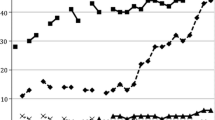Abstract
Many US parents are concerned that vaccinating daughters against human papillomavirus (HPV) will communicate implicit approval for sexual activity and be associated with early or risky sexual behavior (Scarinci et al. in J Womens Health 16(8):1224–1233, 2007; Schuler et al. in Sex Transm Infect 87:349–353, 2011) [7, 8]. The aims of this study were to understand (a) whether the HPV vaccine was associated with risky sexual behavior among a diverse sample of female adolescents and young adults, and (b) to better understand the chronology of HPV vaccination and sexual behavior. An anonymous web-based survey was used to collect data from 114 female community college students. T test and Chi square analyses were used to compare vaccinated and unvaccinated groups on age at first intercourse and proportion who had ever had sexual intercourse. Linear multiple regression was used to predict frequency of condom use and number of sexual partners in the past year, using vaccination status and demographic factors as predictors. About 38 % reported receiving at least one dose of the HPV vaccine. Many of those vaccinated (45 %) received the vaccine after having initiated sexual activity. The proportion of women who were sexually experienced did not differ by HPV vaccine status, nor did age at first intercourse, number of partners in the past year, or frequency of condom use. Current findings suggest that HPV vaccination is not associated with riskier sexual activity for the young women in this sample. Adolescents and their parents may benefit from education about the need to receive the HPV vaccine before onset of sexual activity.
Similar content being viewed by others
References
Romanowski, B., de Borba, P. C., Naud, P. S., et al. (2009). Sustained efficacy and immunogenicity of the human papillomavirus (HPV)-16/18 AS04-adjuvanted vaccine: Analysis of a randomized placebo-controlled trial up to 6.4 years. Lancet, 374, 1975–1985.
Villa, L. L., Costa, R. L. R., Petta, C. A., et al. (2006). High sustained efficacy of a prophylactic quadrivalent human papillomavirus types 6/11/16/18 L1 virus-like particle vaccine through 5 years of follow-up. British Journal of Cancer, 95, 1459–1466.
CDC. (2011). Recommended adult immunization schedule: United States, 2011. MMWR, 60(4), 1–4.
CDC. (2011). Recommended immunization schedules for persons aged 0 through 18 years: United States, 2011. MMWR, 60(5), 1–4.
CDC. (2013). Adult vaccination coverage: United States, 2011. MMWR, 62(4), 66–72.
CDC. (2012). National and state vaccination coverage among adolescents aged 13 through 17 years: United States, 2011. MMWR, 61(34), 671–677.
Scarinci, I. C., Garcès-Palacio, I. C., & Partridge, E. E. (2007). An examination of acceptability of HPV vaccination among African American women and Latina immigrants. Journal of Women’s Health, 16(8), 1224–1233.
Schuler, C. L., Reiter, P. L., Smith, J. S., et al. (2011). Human papillomavirus vaccine and behavioural disinhibition. Sexually Transmitted Infection, 87, 349–353.
Mullins, T. L. K., Zimet, G. D., Rosenthal, S. L., et al. (2012). Adolescent perceptions of risk and need for safer sexual behaviors after first human papillomavirus vaccination. Archives of Pediatric and Adolescent Medicine, 166, 82–88.
Bednarczyk, R. A., Davis, R., Ault, K., Orenstein, W., & Omer, S. B. (2010). Sexual activity-related outcomes after human papillomavirus vaccination of 11- to 12-year-olds. Pediatrics, 130, 798–805.
Liddon, N. C., Leichliter, J. S., & Markowitz, L. E. (2012). Human papillomavirus vaccine and sexual behavior among adolescent and young women. American Journal of Preventive Medicine, 42, 44–52.
Marchand, E., Glenn, B., & Bastani, R. (2012). Low HPV vaccine coverage among female community college students. Journal of Community Health, 37, 1136–1144.
Allen, J., Othus, M., Shelton, R. C., et al. (2010). Parental decision making about the HPV vaccine. Cancer Epidemiology, Biomarkers and Prevention, 19, 2187–2198.
Bastani, R., Glenn, B., Tsui, J., et al. (2011). Understanding sub-optimal HPV vaccine uptake among ethnic minority girls. Cancer Epidemiology, Biomarkers and Prevention, 20, 1463–1472.
Roberts, M., Gerrard, M., Reimer, R., & Gibbons, F. (2010). Mother-daughter communication and human papillomavirus vaccine uptake by college students. Pediatrics, 125, 982–989.
Metzler, C. W., Noell, J., & Biglan, A. (1992). The validation of a construct of high-risk sexual behavior in heterosexual adolescents. Journal of Adolescent Research, 7, 233–249.
Safran, D. G., Kosinski, M., Tarlov, A. R., et al. (1998). The primary care assessment survey: Tests of data quality and measurement performance. Medical Care, 36, 728–739.
Veldhuijze, N. J., Snijders, P. J. F., Reiss, P., Meijer, C. J. L. M., & van de Wijgert, J. H. H. M. (2010). Factors affecting transmission of mucosal human papillomavirus. Lancet Infectious Disease, 10, 862–874.
Forhan, S. E., Gottlieb, S. L., Sternberg, M. R., et al. (2009). Prevalence of sexually transmitted infections among female adolescents aged 14–19 in the United States. Pediatrics, 124, 1505–1512.
Stupiansky, N. W., Zimet, G. D., Cummings, T., Fortenberry, J. D., & Shew, M. (2012). Accuracy of self-reported human papillomavirus vaccine receipt among adolescent girls and their mothers. Journal of Adolescent Health, 50, 103–105.
Acknowledgments
This research was supported by the UCLA Cancer Education and Career Development Program, NCI Grant R25 CA 087949-13 and a grant from the UCLA Jonsson Cancer Center Foundation. The authors also wish to thank the staff and students of the Los Angeles Community College District, who made this research possible.
Author information
Authors and Affiliations
Corresponding author
Rights and permissions
About this article
Cite this article
Marchand, E., Glenn, B.A. & Bastani, R. HPV Vaccination and Sexual Behavior in a Community College Sample. J Community Health 38, 1010–1014 (2013). https://doi.org/10.1007/s10900-013-9710-0
Published:
Issue Date:
DOI: https://doi.org/10.1007/s10900-013-9710-0




